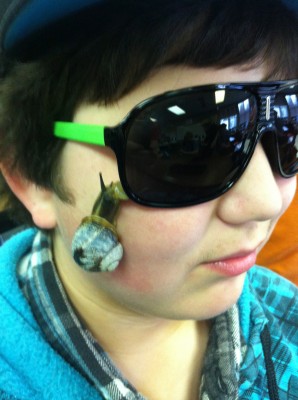Live animals in Science class are great. For the past 15 years that I’ve been teaching mostly Science I’ve mainly taught Earth, Physical, and Environmental Science. Even in Environmental Science we barely worked with live animals. I did get to trap fish with students but we just caught, identified, then returned them to the creek. We didn’t get to “play” with them. We also got to identify benthic macroinvertebrates but even though they are macro, big enough to see with the naked eye, they are still very small. We end up putting those back too after watching them with digital microscopes. Pretty cool. We’ve had classroom pets, from a turtle to a couple of tarantulas but they were mainly there to be cared for not for “Science.”
For the last couple of years I’ve been able to teach Life Science, which is new to me, and I got a Foss kit, Diversity of Life, which included two units where students get to experiment with animals. Don’t worry, by experiment I don’t mean anything mean. We practice ethical caring of our animals. I tell my students that it’s none of my business what they do outside of my classroom but in my Science classes we will treat our animals ethically and cause them NO harm.
My 8th graders get to work with land snails and Madagascar Hissing Cockroaches! And by, “get to work,” I mean that they actually design and carry out their own experiments to learn about animal behavior and preferences. Now this is what I call doing real Science. I love this kind of stuff and this is what I envisioned when I started teaching Science. In Physical Science we get to do a lot of experimenting and in Environmental Science we also get to carry out investigations out in the field so when I started teaching Life Science I was excited that we got to work with LIVE animals in this way. Earth Science was difficult but I taught it long enough to get ideas for experiments from the courses I took so we had a great Earth Science course for our students too.
We actually learn with living things when we look at microscopic critters like paramecia and amoeba, but they are difficult to handle so our snails and cockroaches are a lot more fun and interesting to students. Frankly, I thought the microscopic world would be more interesting to kids but as it turns out, not as much as I thought. I’m still perplexed about that. Maybe it has something to do with the difficulty of the microscopes themselves. In the animal kingdom we start with land snails.
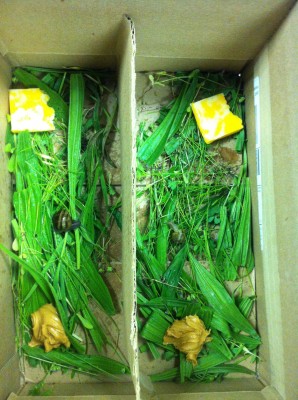
Here’s a situation one team developed to determine whether or not snails would eat cheese or peanut butter, and if so, which one they preferred. They use two snails to see if there was a difference between snails or if they could generalize for all or most snails.
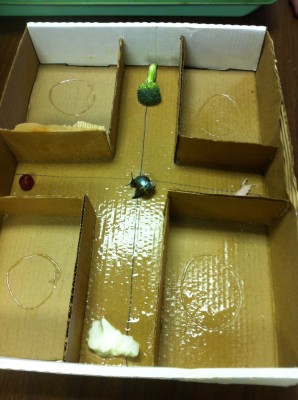
This snail was given four choices of food to choose from. Students tried to limit its range of movement and they moistened the box to help the snail want to move.
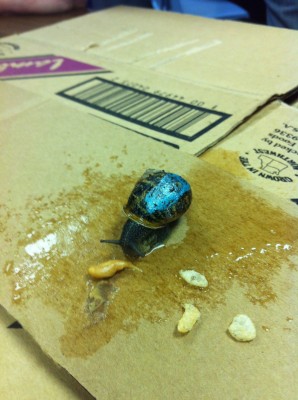
This snail was given only food choices. The decoration on the shell was done so that students could find their snail the next day (it’s not a new variety of land snail). Watching snails eat is very fun.
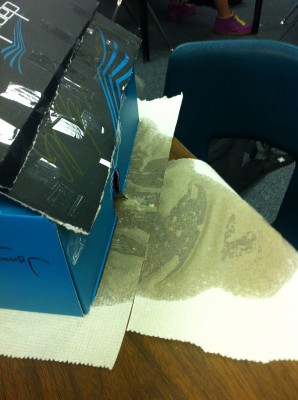
These snails were given lovely accommodations. This team wanted to see if snails preferred dark versus light. As they guessed, it was difficult to get them to come out of their lovely house.
I waited until spring and then went hunting for snails. Luckily, we found enough snails so that my two classes could carry out all their investigations. At first the kids were wary to say the least. “Why do we have to work with snails?” “They’re gross.” “I hate snails.” On and on those comments went. Yet once they actually got to work with their snails most if not all kids fell in love with their new, little friends. It was actually quite cute to see these 8th graders with their snails (last year’s 8th graders too!).
The cockroaches are a bit more scary. There are many 8th graders who would not handle a cockroach. Frankly, with my track record of fearing cockroaches growing up in Miami, FL, where the evil-looking and flying palmetto bug cockroaches were everywhere to be found, I don’t handle them either. I’ll touch them and pet them but I won’t hold one. It freaks me out.
Luckily, each year we’ve had from one to a few kids in each class who not only hasn’t minded handling the cockroaches, they’ve actually loved handling the cockroaches. They are the ones who get the roaches out of the tank, we have about 15 or more of them, bring them to teams and then get them back into the tank.
Roach in a maze. This team made a maze to see if they could train their roach to get through the maze. It was more difficult than they thought and required much patience.
Roach and soap. This team actually made some great discoveries of how these roaches react to the foam soap we use to wash our hands. They were able to generalize by using different coaches.
It has been fun and made Life Science, well, come to Life. (As can probably be guessed by this post when I studied Biology I preferred the animal part to the plant part. I don’t know if it’s because of that bias but my students haven’t seemed all that interested in the plant portion of our study as they are in the animal part.)

